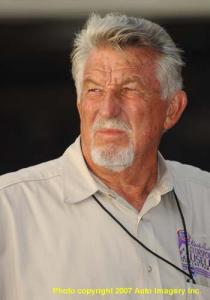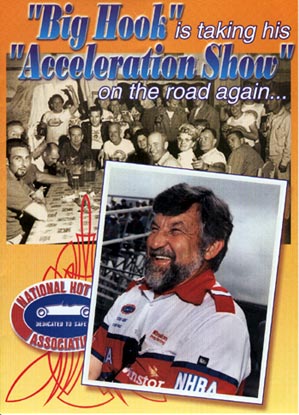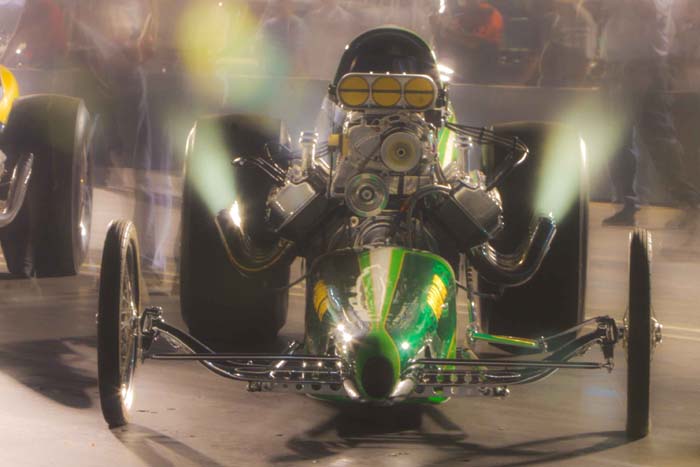GIBBS MAINTAINS THE IMPORTANCE OF THE PAST IN THE PRESENT
 With each passing season, the role Steve Gibbs plays in the drag racing world becomes more important. After 40 years, the veteran official is still an influential figure in the sport.
With each passing season, the role Steve Gibbs plays in the drag racing world becomes more important. After 40 years, the veteran official is still an influential figure in the sport.
The 70-year-old served as the competition director for the NHRA from 1972-97, before being appointed to the post of vice-president of the NHRA Motorsports Museum in Pomona, Calif. Additionally, Gibbs is a consultant to the NHRA. Gibbs also serves as a member of the Museum Board of Directors and of the NHRA Competition Committee.
If those tasks weren’t enough to keep Gibbs busy, he also virtually singlehandedly was responsible for starting an NHRA-sanctioned circuit for nostalgia racers, the NHRA Hot Rod Heritage Series.
“The two biggest things I deal with during the year are the two reunions the NHRA puts on,” Gibbs said. “The California Hot Rod Reunion in Bakersfield (Calif.), and the National Hot Rod Reunion in Bowling Green, Ky. Those are two events that I’m still involved with in up to my neck. We’re looking forward to good years and we had good years with both events last year in light of the economy. We saw pretty major growth at the Bakersfield event when most events in the country were struggling to stay even or hold down the losses. I think the whole museum staff and myself were proud of that fact. We feel like that event serves a need and we’re going to do everything to keep it going. The same with Bowling Green, that’s a great event.”
The Holley NHRA National Hot Rod Reunion is June 18-20 at Beech Bend Raceway in Bowling Green, Ky. The California Hot Reunion is Oct. 15-17 at Famoso Raceway in Bakersfield.
“We try to get veteran racers back together and we try to give the young people the chance to rub elbows with the big names in the sport,” Gibbs said. “I’m also involved with the Heritage Series, which is a modest series of races on the West Coast. I help coordinate those Heritage Series races, but they’re really produced by the track themselves.”
The NHRA Hot Rod Heritage Series has a nine-race schedule, beginning March 5-7 at Famosa Raceway and concluding at the California Hot Rod Reunion.
“The high point of the year for us (last year) was the California Hot Rod Reunion,” Gibbs said. “We had double-digit growth at that event. We want to keep staying in business and provide activity for these racers who want to run in the Heritage Series. It’s a secondary series, but it serves the need to a lot of the tracks. Overall, we had a pretty good year. I’m hopeful things will turn around in the economy and everything will improve. All the way from the bracket races to the biggest national events. We need to have a good year. Last year was a tough year across the board.”
Despite tough economic times, Gibbs thinks the Heritage Series has found a niche.
 “The (Heritage) Series has an appeal to it because it’s traditional drag racing that so many people did over the years,” Gibbs said. “There are a lot of guys around who are 60, 70 years old and that was a big part of their lives. Those guys are still alive and kicking and they enjoy either being involved in the actual racing, being part of the crew or just coming out to the races and getting a chance to visit their friends. You also have a lot of second and third generation people who have heard about what grandpa did and read about it, and there’s just a lot of history in this sport and this a chance to come out and relive a lot of it. It’s a good show with a little bit of everything.”
“The (Heritage) Series has an appeal to it because it’s traditional drag racing that so many people did over the years,” Gibbs said. “There are a lot of guys around who are 60, 70 years old and that was a big part of their lives. Those guys are still alive and kicking and they enjoy either being involved in the actual racing, being part of the crew or just coming out to the races and getting a chance to visit their friends. You also have a lot of second and third generation people who have heard about what grandpa did and read about it, and there’s just a lot of history in this sport and this a chance to come out and relive a lot of it. It’s a good show with a little bit of everything.”
As far as his consultant role with the NHRA, Gibbs is there to offer advice when the sanctioning body asks.
“They will call me now and then, when they want to hear what an old guy has to say,” Gibbs said. “When you do it this long, this is my 40th year with NHRA, there’s a fair amount of experience there that comes into play. I try to offer whatever opinions, guidance I can if asked. Things change and they certainly do not do things now the way they were done when I was doing them, but that’s just evolution. I try to make myself available when needed.
The sport of drag racing is still alive and it has its challenges to keep going and I think the NHRA is making some moves to maybe try to rein in the performances of these cars. The performance of these cars has probably got beyond what some of these facilities should handle. At some point, they’re going to have to figure out a way to reduce the power in these cars. Hopefully, they will be able to control the cost enough to get a full field of cars. It’s going to be a challenge this year with the economy and I know the NHRA is working on things. It’s tough to change. You have guys who are set up to race a certain way and they don’t want to change. It’s going to take some real perseverance and convincing on the NHRA’s part to solve some of the problems that they’re facing. I know they’re working hard at it, but that’s easier said than done.”
Unlike when he was in the grind of being the NHRA’s competition director, Gibbs’ national event schedule these days is more flexible.
“I don’t go to very many events anymore,” said Gibbs, who lives in Huntington Beach, Calif. “I go to the local ones in Pomona a couple of times a year and I will go to Las Vegas. I also try to go to Gainesville. I’ve never missed one of the Gainesville races in the 40 years they has been run. For the 23 race series, the majority of the races, I follow on the internet or on TV. I’m always current with what is going on. After 25 years, after making basically every national event and conducting over 400 national events, it just definitely someone else’s turn.”
Since his departure as competition director, Gibbs says technology has made incredible progress when it comes to putting on races.
“There are a lot better systems with the electronics and the timing systems and the sophistication of the staging crew,” Gibbs said. “When you have a 23-race series, you have full-time people working for you. When I started it out almost everybody was a weekend volunteer, so you almost had to start from scratch on every national event as far as your procedures and layouts. Now, the venues move, but the procedures are pretty much the same and that makes it easier. I’m not saying it is easier to do, but when you get that repetition and get on a roll, things are a little more predictable.”
Considering Gibbs spends most of his time with the Hot Rod Heritage series, it begs the question of whether he is planning to add some new classes like a stock eliminator style seniors tour.

“I have not really thought about adding new classes too much,” Gibbs said. “Everybody in the world has an idea of a class they would like to see. I would love to see a little small block injected junior fuel class like we used to have years ago, but I don’t know if that will happen. I think we have a lot of good classes now and a lot of cars out there. We will have over 400 cars at the Bowling Green event for instance. It’s kind of hard to say we want to add more classes because sometimes in certain events, you can’t even accommodate what you have. Plus, so much of that goes back to the individual track. One of the biggest problems we have today is just finding
a place to race on a steady basis, especially on the West Coast.”
Advertisement




































